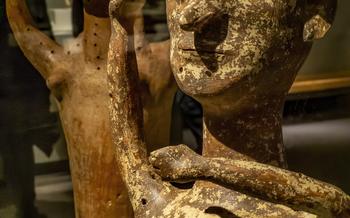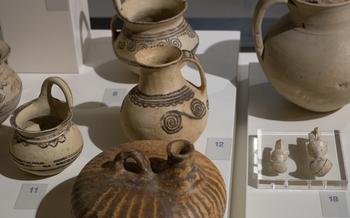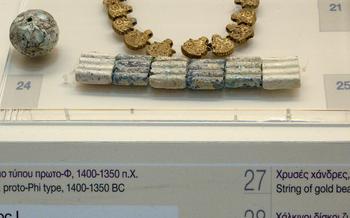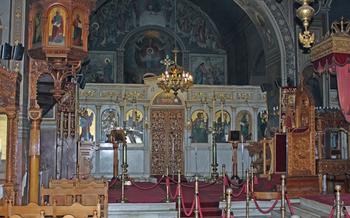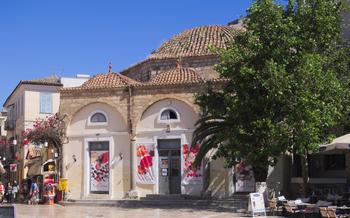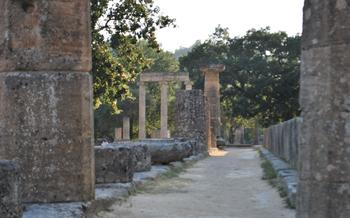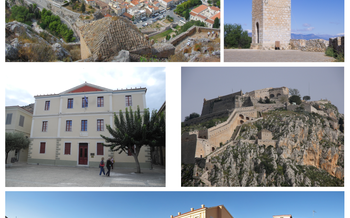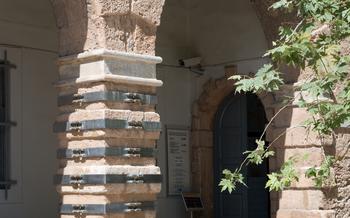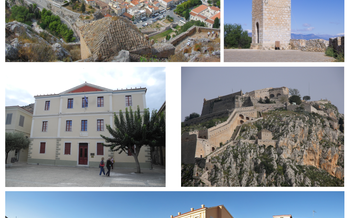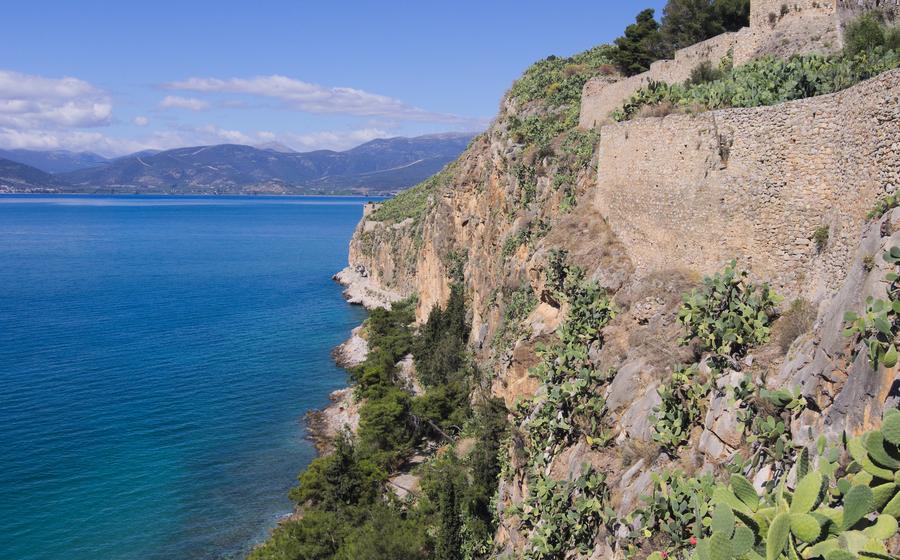
Lion Gate at Mycenae
- Journey Through History: Unraveling the Lion Gate
- Location and Accessibility: Finding the Gateway to Mycenae
- The Mycenaean Civilization: A Legacy of Power and Intrigue
- Mythology and Legends: The Roar of the Lions
- Artistic Masterpiece: Admiring the Lion's Craftsmanship
- A Walk Through Time: Exploring the Mycenaean Acropolis
- The Mycenaean Museum: A Glimpse into the Past
- The Lion Gate in Literature and Art: Immortalized Through the Ages
- The Lion Gate's Place in Archaeological Research
- Experiencing the Lion Gate in Different Seasons
- Photography Tips for Capturing the Lion's Majesty
- Mycenae's Enchanting Surroundings: Beyond the Lion Gate
- Accommodations and Dining Options Near Mycenae
- Events and Festivals: Celebrating Mycenae's Heritage
- Insider Tip: Unveiling a Hidden Gem
Journey Through History: Unraveling the Lion Gate
At the heart of the ancient city of Mycenae, a majestic gateway awaits, known as the Lion Gate. This iconic monument stands as a testament to the ingenuity and artistry of the Mycenaean civilization, which flourished in Greece during the Bronze Age.
The Lion Gate, constructed in the 13th century BC, serves as the grand entrance to the Mycenaean Acropolis, a fortified citadel that was once the center of Mycenaean power. Its imposing presence and intricate carvings have fascinated historians, archaeologists, and travelers for centuries.
The gate's most striking feature is the pair of majestic lions that flank the entrance. These life-size sculptures, carved from a single block of limestone, exude both strength and elegance. The lions stand atop a triangular pediment, their heads turned outward as if to guard the entrance to the city.
Beyond its architectural significance, the Lion Gate holds deep symbolic and mythological meanings. The lions are believed to represent the power and ferocity of the Mycenaean rulers, serving as a warning to potential enemies. They are also associated with the goddess Artemis, who was worshipped as the protector of the city.
The construction techniques employed in the Lion Gate showcase the advanced engineering skills of the Mycenaeans. The massive stone blocks were carefully fitted together without the use of mortar, demonstrating their mastery of building techniques.
The Lion Gate has been the subject of numerous theories and interpretations. Some scholars believe that it was built as a defensive structure, while others suggest that it served a ceremonial or religious purpose. Ongoing archaeological research continues to shed light on the mysteries surrounding this ancient monument.
Location and Accessibility: Finding the Gateway to Mycenae
The Lion Gate stands as the grand entrance to the ancient city of Mycenae, located in the northeastern Peloponnese region of Greece. This archaeological marvel lies approximately 90 kilometers southwest of Athens, making it a convenient day trip from the capital.
- Transportation Options:
- By Car: Embark on a scenic drive through the picturesque Greek countryside. Mycenae is easily accessible by car, with well-maintained roads leading to the site.
-
By Public Transport: For a budget-friendly option, take a bus from Athens to Mycenae. The journey takes around 2 hours and offers stunning views along the way.
-
On-site Facilities:
- Visitor Center: Begin your exploration at the modern visitor center, where you can purchase tickets, obtain maps, and learn more about the history of Mycenae.
- Signage and Guides: Navigate the archaeological site with ease thanks to informative signage and guided tours available in multiple languages.
-
Facilities for Visitors: Enjoy the convenience of restrooms, a small café, and a gift shop within the premises.
-
Planning Your Visit:
- Optimal Timing: Aim to arrive early in the morning or late afternoon to avoid the midday heat and crowds.
- Suitable Attire: Wear comfortable shoes, as the site involves walking on uneven terrain. Sun protection is also essential.
- Photography Enthusiasts: Capture the gate's grandeur in all its glory with your camera, but be mindful of restricted areas.
- Accessibility: While the site is wheelchair accessible, some areas may present challenges due to uneven surfaces.
The Mycenaean Civilization: A Legacy of Power and Intrigue
The Mycenaean civilization flourished in mainland Greece during the Bronze Age, leaving behind a legacy of architectural wonders, advanced social structures, and significant cultural achievements. This civilization, named after the ancient city of Mycenae, played a pivotal role in shaping the course of Greek history and laid the foundation for the later classical Greek civilization.
The Mycenaeans emerged as a powerful force around 1600 BC, establishing their influence over much of the Peloponnese region and beyond. Their centralized political system, ruled by a king, facilitated the construction of impressive fortifications, palaces, and tombs, including the famed Lion Gate. Their prowess in engineering and architecture is evident in the monumental structures they left behind, showcasing their mastery of stonework and innovative building techniques.
The Mycenaeans were skilled craftsmen, creating intricately designed pottery, jewelry, and other artifacts that showcased their artistic talents and technical expertise. Trade and cultural exchange with other civilizations, such as the Minoans of Crete and the Hittites of Anatolia, further enriched their cultural landscape. Through these interactions, the Mycenaeans absorbed new ideas and technologies, contributing to their own cultural development and leaving a lasting impact on the broader Mediterranean world.
Archaeological discoveries at Mycenae and other sites have provided valuable insights into their way of life. Excavations have unearthed elaborate palaces, adorned with frescoes and colorful wall paintings, offering glimpses into their royal lifestyle and administrative practices. The discovery of clay tablets inscribed with Linear B script, an early form of writing, has shed light on their language, economy, and social organization, providing a window into their complex administrative system.
Mythology and Legends: The Roar of the Lions
The Lion Gate is steeped in ancient myths and legends that have captivated imaginations for centuries. One of the most famous tales associated with the gate is the story of Hercules and the Nemean Lion. According to Greek mythology, Hercules was tasked with slaying the ferocious Nemean Lion as his first labor. The lion was said to be invincible, with a hide that could not be pierced by any weapon. Hercules tracked the lion to its lair near Mycenae and engaged it in a fierce battle. After a grueling struggle, Hercules managed to strangle the lion to death with his bare hands. The gate's imposing lions are often interpreted as symbols of strength and courage, embodying the triumph of Hercules over the Nemean Lion.
The lions also held a significant role in Mycenaean mythology. They were believed to be guardians and protectors of the city, representing the power and majesty of the Mycenaean civilization. The gate's location at the entrance to the city further reinforced this symbolism, as it served as a symbolic threshold between the mortal world and the sacred realm of the gods. The lions' fierce appearance was meant to ward off evil spirits and protect the city from any threats.
Artistic Masterpiece: Admiring the Lion's Craftsmanship
The Lion Gate is not just a historical relic; it is a breathtaking work of art that showcases the incredible skill and artistry of the Mycenaean civilization. The gate's most striking feature is the pair of majestic lions that flank the entrance. Carved from a single block of limestone, these imposing figures display an impressive level of detail and realism. The lions' muscular bodies, fierce expressions, and flowing manes are rendered with remarkable precision, capturing their power and majesty.
The gate's triangular lintel above the lions is adorned with intricate relief carvings depicting two columns topped by volutes and spirals. These decorative elements are believed to symbolize the sacred pillars that supported the palace roof, representing the strength and stability of the Mycenaean kingdom. The lintel also features a central rosette motif, which is a common symbol of the sun or the goddess Artemis in ancient Greek art.
The Lion Gate is a testament to the artistic prowess of the Mycenaeans. Its intricate carvings and sculptures demonstrate their mastery of stoneworking and their ability to create lifelike representations of animals and mythical creatures. The gate's artistic significance extends beyond its historical value, making it a must-see for anyone interested in ancient art and architecture.
A Walk Through Time: Exploring the Mycenaean Acropolis
Venturing beyond the Lion Gate, visitors can embark on a captivating journey through the Mycenaean Acropolis, an ancient citadel that once served as the heart of Mycenaean civilization. Here, history unveils itself through a series of remarkable landmarks that transport visitors back in time.
Among the must-see attractions is the Treasury of Atreus, an awe-inspiring beehive-shaped tomb constructed from massive stone blocks. Its impressive domed ceiling and intricate carvings offer a glimpse into the architectural prowess of the Mycenaeans.
The Cyclopean Walls, with their colossal stone blocks, stand as testaments to the engineering ingenuity and defensive capabilities of this ancient city. These towering fortifications once protected the acropolis and its inhabitants from potential invaders.
Exploring the acropolis, visitors can imagine the daily lives and rituals of the Mycenaeans. They can envision the bustling marketplaces, the sacred temples, and the royal palaces that once occupied this fortified hilltop.
To fully appreciate the significance of these ancient ruins, it's advisable to take a guided tour or consult informative guidebooks. These resources provide insights into the history, purpose, and construction techniques of each landmark, enhancing the overall experience for visitors.
The Mycenaean Museum: A Glimpse into the Past
Located a short walk from the Lion Gate, the Mycenaean Museum is a treasure trove of artifacts and exhibits that showcase the rich culture and history of the Mycenaean civilization. As you step inside, you'll be transported back in time to the Bronze Age, where the Mycenaeans ruled over the Peloponnese.
The museum's collection is a testament to the artistry and craftsmanship of the Mycenaeans. Among the highlights are exquisite gold jewelry, intricately painted pottery, and bronze weapons and armor. These artifacts provide a glimpse into the daily lives, rituals, and beliefs of this ancient civilization.
One of the most captivating exhibits is the gold death mask of Agamemnon, discovered by Heinrich Schliemann in the 19th century. This iconic artifact, believed to depict the legendary king of Mycenae, is a symbol of the wealth and power of the Mycenaean rulers.
The museum also features interactive displays and educational resources that bring the Mycenaean civilization to life. Visitors can learn about the Mycenaeans' writing system, their trade networks, and their interactions with other cultures.
Whether you're a history buff, an archaeology enthusiast, or simply curious about the ancient world, the Mycenaean Museum is a must-visit destination. It offers a unique opportunity to immerse yourself in the fascinating world of the Mycenaeans and gain a deeper understanding of their legacy.
The Lion Gate in Literature and Art: Immortalized Through the Ages
The Lion Gate has permeated the realms of literature and art, leaving an indelible mark on cultural expression. Ancient texts, such as Homer's Iliad, make mention of the gate's significance, weaving it into the tapestry of Greek mythology.
In the realm of visual arts, the gate has been immortalized in paintings, sculptures, and other artistic creations. Renowned artists, captivated by its majesty, have sought to capture its essence on canvas and in stone.
One notable depiction can be found in the painting "The Lion Gate of Mycenae" by German artist Ludwig Thiersch. Created in 1837, this oil on canvas masterpiece portrays the gate in all its grandeur, set against a backdrop of the surrounding landscape.
The gate's enduring fascination has also inspired modern interpretations and artistic representations. In contemporary art installations, sculptures, and even digital creations, artists continue to draw inspiration from the Lion Gate, reinterpreting its symbolism and exploring its timeless allure.
The gate's presence in literature and art underscores its profound impact on the human imagination. It stands as a testament to the enduring power of ancient symbols and the ability of art to transcend time and culture.
The Lion Gate's Place in Archaeological Research
The Lion Gate stands as a testament to the enduring legacy of the Mycenaean civilization and continues to captivate archaeologists and scholars worldwide. Ongoing excavations and discoveries at Mycenae have shed new light on the gate's construction, purpose, and significance.
Archaeological teams have unearthed a wealth of artifacts and evidence that provide clues to the gate's origins and the lives of the Mycenaeans. These discoveries have sparked ongoing debates and theories among experts, leading to a deeper understanding of this ancient civilization.
International collaboration and the exchange of knowledge among archaeologists have been instrumental in advancing research on the Lion Gate. Scholars from diverse backgrounds contribute their expertise, fostering new perspectives and interpretations.
Preserving and studying the Lion Gate are of paramount importance for future generations. Through ongoing research and collaboration, we can unlock the secrets of this iconic landmark and gain a profound appreciation for the ingenuity and artistry of the Mycenaean civilization.
Experiencing the Lion Gate in Different Seasons
The Lion Gate exudes a distinct charm and atmosphere in each season, offering visitors a unique perspective on its grandeur.
During the summer months, the gate basks in the warm sunlight, casting long shadows that accentuate its intricate carvings. While the crowds can be substantial during this time, the vibrant energy and buzz of activity create a lively atmosphere. To avoid the throngs of tourists, consider visiting early in the morning or late in the afternoon, when the sun is less intense and the crowds have thinned.
In autumn, the surrounding landscape transforms into a tapestry of golden hues, providing a picturesque backdrop for the gate. The crisp, cool air adds a touch of tranquility to the atmosphere, making it an ideal time toじっくりと explore the archaeological site and soak in its history.
Winter brings a sense of solitude and serenity to Mycenae. With fewer visitors around, you can fully appreciate the gate's grandeur without the hustle and bustle. The snow-capped mountains in the distance create a breathtaking contrast to the ancient ruins, offering a unique perspective on this historical site.
Springtime at the Lion Gate is a feast for the senses. The surrounding hillsides burst into bloom, painting the landscape with vibrant colors. The wildflowers sway gently in the breeze, adding a touch of magic to the atmosphere. With the weather being pleasant and mild, springtime is an excellent time to explore the archaeological site and its surroundings at a leisurely pace.
Photography Tips for Capturing the Lion's Majesty
To immortalize the grandeur of the Lion Gate through photography, meticulous attention to camera settings and techniques is crucial. Utilize a tripod for stability, ensuring sharp and crisp images. Experiment with different angles and vantage points to capture the gate's imposing presence. Harness the power of natural light, particularly during the golden hours of sunrise and sunset, to enhance the colors and textures of the stonework. Compose creative shots by incorporating elements of the surrounding landscape or sky to create a sense of depth and context. Embrace the opportunity to capture the gate's majesty in different seasons, as each brings its own unique charm and atmosphere. Whether it's the vibrant colors of spring, the warm glow of summer, the autumnal hues, or the ethereal beauty of winter, the Lion Gate offers a myriad of photographic possibilities.
Mycenae's Enchanting Surroundings: Beyond the Lion Gate
While the Lion Gate stands as the iconic symbol of Mycenae, the region offers a wealth of additional treasures waiting to be discovered. Just a short drive from Mycenae lies the picturesque town of Nafplio, a charming port city with a rich history and Venetian-influenced architecture. Stroll along the cobblestone streets, explore the ancient fortress of Palamidi, and soak in the vibrant atmosphere of this seaside gem.
Venture further afield to uncover the ancient theater of Epidaurus, a marvel of acoustic engineering that has hosted performances for over two millennia. Marvel at the remarkably preserved stone seats and experience the magic of a live performance in this awe-inspiring setting.
The Peloponnese region itself is a treasure trove of natural beauty, with stunning landscapes, pristine beaches, and hidden gems waiting to be explored. From the lush forests of Mount Taygetos to the rugged coastline of the Mani Peninsula, there's something for every nature lover to discover.
Consider planning a multi-day itinerary to fully immerse yourself in the region's rich history and culture. Combine visits to ancient sites like Mycenae and Epidaurus with explorations of charming towns, scenic hikes, and unforgettable culinary experiences. The Peloponnese offers a captivating blend of history, nature, and authentic Greek culture that will leave you spellbound.
Accommodations and Dining Options Near Mycenae
When planning your trip to Mycenae, finding comfortable accommodations and delectable dining options is essential. For a truly immersive experience, consider staying in one of the charming hotels or guesthouses in the nearby town of Nafplio. These accommodations offer a range of options to suit different budgets and preferences, from traditional Greek guesthouses to modern boutique hotels.
To savor the authentic flavors of the region, venture into the local restaurants, where you can indulge in traditional Greek cuisine. Sample mouthwatering dishes such as freshly caught seafood, succulent grilled meats, and flavorful vegetarian options. Don't miss the opportunity to try local specialties like moussaka, pastitsio, and spanakopita, all bursting with Mediterranean flavors.
For budget-conscious travelers, there are several affordable options available. Hostels and guesthouses offer a comfortable and social environment, while budget-friendly tavernas serve delicious and reasonably priced meals. With a bit of research, you can easily find options that suit your budget without compromising on quality or experience.
Whether you prefer a luxurious stay in a charming hotel or a cozy bed in a family-run guesthouse, Nafplio has something to offer every traveler. Savor the flavors of traditional Greek cuisine, indulge in local specialties, and immerse yourself in the vibrant culinary scene of the region.
Events and Festivals: Celebrating Mycenae's Heritage
Mycenae and the surrounding region come alive during various cultural events and festivals that celebrate the rich heritage of the area. Participating in these festivities offers a unique opportunity to experience the vibrant traditions and customs of the Peloponnese. Attend traditional dance performances, listen to enchanting music, and witness captivating theatrical reenactments that bring the Mycenaean era to life. Immerse yourself in the local culture by sampling delicious traditional dishes, learning about ancient crafts, and engaging with friendly locals who are passionate about sharing their heritage. To make the most of your visit, research upcoming events before your trip and plan your itinerary accordingly. These festivals provide an unforgettable glimpse into the heart and soul of Mycenae and its people.
Insider Tip: Unveiling a Hidden Gem
While exploring the wonders of Mycenae, don't miss the opportunity to uncover a hidden gem just a short distance away. Nestled amidst the picturesque countryside, you'll stumble upon the enchanting site of Midea. This ancient city, often overshadowed by its more famous neighbor, boasts its own impressive history and archaeological treasures.
Step back in time as you wander through the remnants of Midea's ancient streets and fortifications. Discover the fascinating ruins of its palace, temples, and houses, which offer a glimpse into the daily lives of the Mycenaeans who once called this place home.
As you explore Midea, you'll be struck by its serene atmosphere, far from the crowds that flock to Mycenae. Take advantage of this tranquil setting to truly immerse yourself in the history and beauty of this lesser-known gem.
Remember, the best travel experiences often come from venturing beyond the beaten path and exploring hidden treasures like Midea. So, embrace the spirit of discovery and let the Peloponnese region captivate you with its endless wonders.
